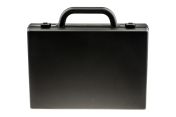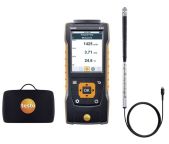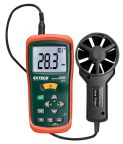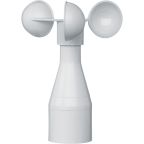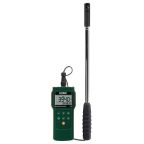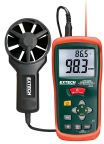Anemometers
An anemometer, also known as a wind speed meter or airflow meter, is a device used to measure wind speed and air velocity. It's a standard tool in weather stations, HVAC systems, and various industrial applications. For a more in-depth understanding, please see our complete guide to anemometers.
Anemometers can accurately monitor wind speed and provide data for the measurements in various formats, depending on the technology used. There are several types of anemometers, and each one functions differently depending on what type it is and what type of wind measurement application it is used for. Most handheld wind speed meters are rugged and durable to withstand the elements that they may be presented with, as well as being weatherproof, especially those that can be mounted to measure over long periods of time. Also, airflow meters are used in a variety of applications, from weather predictions to high-tech scientific research labs.
Types of Anemometers
The types of anemometers depend on the type of measurement application it is used for. Below are some common types:
Cup Anemometers
Cup anemometers are the simplest type, featuring spinning cups mounted on a pole. As wind passes, the cups rotate, and the meter calculates the wind speed. These anemometers are ideal for weather stations and meteorological applications, providing reliable wind speed readings.
Vane Anemometers
Vane anemometers, also known as propeller or windmill anemometers, use rotating blades to measure wind speed and air velocity. These meters are commonly used in HVAC testing and industrial airflow measurements, providing accurate wind velocity data.
Pressure-tube (Pitot Tube) Anemometer
Pressure-tube anemometers, often using a Pitot tube, measure wind speed by detecting the difference between static and dynamic pressure. These meters are commonly used in aerospace, automotive testing, and fluid dynamics research, providing precise airflow measurements, especially in high-velocity environments. They are less affected by turbulence than some other types.
**Hot-wire (Thermal) Anemometers **
Hot-wire (thermal) anemometers utilize a heated wire that cools down as airflow passes over it. The amount of cooling is directly related to the air velocity. And since they’re commonly made for handheld usage, these types of anemometers are often portable.
Thermal Anemometers with Velocity/Temperature Profiling
Thermal anemometers with velocity/temperature profiling measure both air velocity and temperature using small sensors. In the Philippines, these meters are used in wind tunnels and electronics cooling analysis, providing detailed wind velocity data.
Ultrasonic Anemometers
Ultrasonic anemometers use high-frequency sound waves to determine wind speed and direction. Additionally, they have two of three pairs of sound transmitters and receivers mounted at right angles to one another. Built-in electronic circuits then measure the time it takes for the sound to make its way from each transmitter to the corresponding receiver. It’s also worth noting that digital ultrasonic meters are typically used for high-precision meteorological and industrial applications.
Anemometer Applications in Industries
Anemometers are versatile tools with applications across various industries in the Philippines, providing crucial data for environmental monitoring, industrial processes, and research. Here are some of their applications:
Weather Monitoring and Forecasting
Anemometers play a vital role in weather monitoring and forecasting, helping track wind patterns and climate conditions. By providing accurate wind velocity data, airflow meters assist meteorologists in the Philippines in predicting weather changes and issuing timely warnings.
HVAC and Ventilation Systems
In HVAC and ventilation systems, anemometers ensure proper air circulation in industrial, commercial, and residential buildings. They measure airflow in ducts, vents, and other critical points, helping technicians optimize system performance, improve energy efficiency, and maintain comfortable indoor environments.
Aerospace and Wind Turbine Testing
Anemometers are essential in aerospace and wind turbine testing, evaluating wind conditions for flight safety and energy production. These meters provide critical data on wind velocity and direction, enabling engineers to design and optimize aircraft and wind turbine performance.
Agriculture and Crop Management
In agriculture and crop management, anemometers determine optimal conditions for irrigation and crop spraying. By measuring wind speed and direction, they help farmers avoid pesticide drift and ensure efficient water usage, contributing to sustainable agricultural practices within the Philippines.
Construction and Safety
Anemometers are used on construction sites to monitor wind conditions, ensuring worker safety when operating cranes, scaffolding, and other equipment. They help prevent accidents caused by high winds.
How to Choose the Right Anemometer
Selecting the appropriate anemometer depends on your specific needs and application. Consider these factors to make an informed decision:
- Measurement Type: Determine whether you need to measure wind speed, air velocity, airflow volume, or wind direction. Remember, different anemometers specialize in these measurements.
- Air Velocity Range: Ensure the anemometer’s range covers the expected wind speeds in your application.
- Application Needs: Identify your primary application, such as weather monitoring, HVAC, industrial processes, or research. By determining where you’ll use the airflow meter, you can easily choose the right type and features.
- **Portability: **Choose between handheld anemometers for portable use or fixed/mounted models for continuous monitoring.
- Accuracy and Sensitivity: Evaluate the required precision level for your application. Note that some anemometers offer higher accuracy and sensitivity than others.
- Additional Features: Consider features like digital displays, data logging capabilities, and temperature/humidity measurement, which can enhance usability.
- Budget Considerations: Balance the desired features with your budget. Consider that some anemometers offer advanced functionality at a higher price point.
Why Choose RS for Anemometers?
RS is your trusted anemometer supplier in the Philippines, offering a wide selection of high-quality anemometers from leading brands. We understand the importance of accurate measurements, which is why we provide a range of anemometers to suit various applications and budgets.
And whether you need an anemometer, digital temperature meter, handheld multimeter, or HVAC multimeter, you can always expect competitive prices from RS Philippines. With our fast delivery services, you can get the tools you need quickly and efficiently. Our commitment to quality and customer satisfaction makes us the ideal choice for your anemometer needs.
Buy Anemometers in the Philippines
If you’re looking to buy anemometers in the Philippines, choose RS. With our comprehensive range of anemometers for various industrial and environmental applications, you can find the perfect airflow meter for your needs. Plus, we aim to make our products affordable and reasonably priced, which is why we offer bulk purchase options.
Shop our selection today and experience reliable measurements with RS Philippines.
Popular Searches
Related links
- How to Measure Wind Speed and Direction
- A Complete Guide to Anemometers
- Kestrel KESTREL 2000 Rotary Vane Anemometer Measures Air Velocity Wind Chill
- Kestrel 0850LBLK Impeller Anemometer Measures Air Flow Density Dew Point,
- Kestrel 0855LVYEL Impeller Anemometer Measures Air Flow Density Dew Point,
- Extech AN100 Anemometer Measures Air Flow Temperature
- Extech AN300 Anemometer Measures Air Flow, Air Velocity
- RS PRO DT-8880 Anemometer Measures Air Flow Temperature





